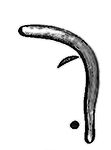is but reasonable to suppose that, if the Egyptians had had any knowledge of a weapon having the peculiarities of the Wonguim, it would have been represented in use by sportsmen in such a manner as to leave no room for doubt as to its character. Its mode of return to the sportsman would have been accurately depicted by the ingenious artists who have told us by figures on their monuments the most minute circumstances attending the uses of weapons and tools amongst that ancient people.
Wilkinson says that "the throw-stick was made of heavy wood, and flat, so as to offer little resistance to the air in its flight; and the distance to which an expert arm could throw it was considerable, though they always endeavoured to approach the birds as near as possible under cover of the bushes and reeds. It was from one foot and a quarter to two feet in length, and about one and a half inch in breadth, slightly curved at the upper end; but in no instance had it the round shape and flight of the Australian Boomerang."
Nearly all the writers in Europe who have treated of the Australian boomerang, as I have stated already, appear to have been misinformed as to the character of the weapon; but the most extraordinary error is that made by Bonomi. He gives drawings of the Egyptian bommereng and that held in the hand of Nimrod, and proceeds to say—"The most curiously carved is that from Southern Africa, the Hunga Munga (Fig. 107); it is made of iron, and used to throw at a retreating enemy. The Trombash (Fig. 108) is from Central Africa, from the neighbourhood of Dar Foor; it is like the former, of iron, and chiefly used in war. The two following are made of wood. Fig. 109, called Es-sellem, is that used by the pastoral tribes of the Desert, between the Nile and the Red Sea; and Fig. 110 is the Australian bommereng. We have given the sections of these missiles, as we conceive that peculiar property of returning towards the thrower may be in some measure dependent on its flatness, although an ancient Egyptian one in the collection of Dr. Abbott, of Cairo, is round, like the Sellem of the Bishareen, and like it also made of the sunt-tree, the Mimosa Nilotica, an excessively hard wood. . . . . . The Australian bommereng is much more curved than either of the specimens we have given, and possesses in a higher degree the singular property of returning to within a few yards of the thrower."[1]
 |
 |
 |
 |
|
| FIG. 107. | FIG. 108. | FIG. 109. | FIG. 110. |
I know not what may be the behaviour of the weapons here figured when thrown, but they differ essentially in form from the Wonguim of the Australians.
- ↑ Nineveh and its Palaces, by Joseph Bonomi, F.R.S.L., pp. 135-6.

